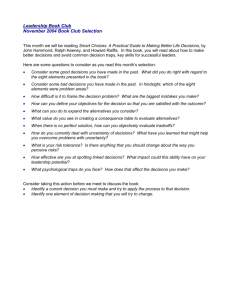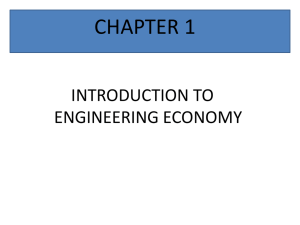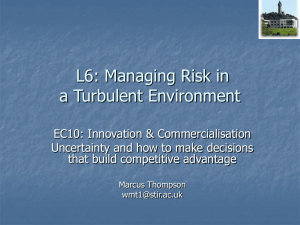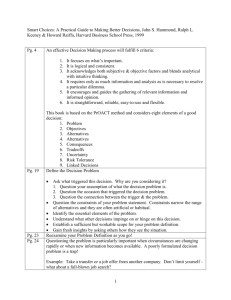Read More
advertisement
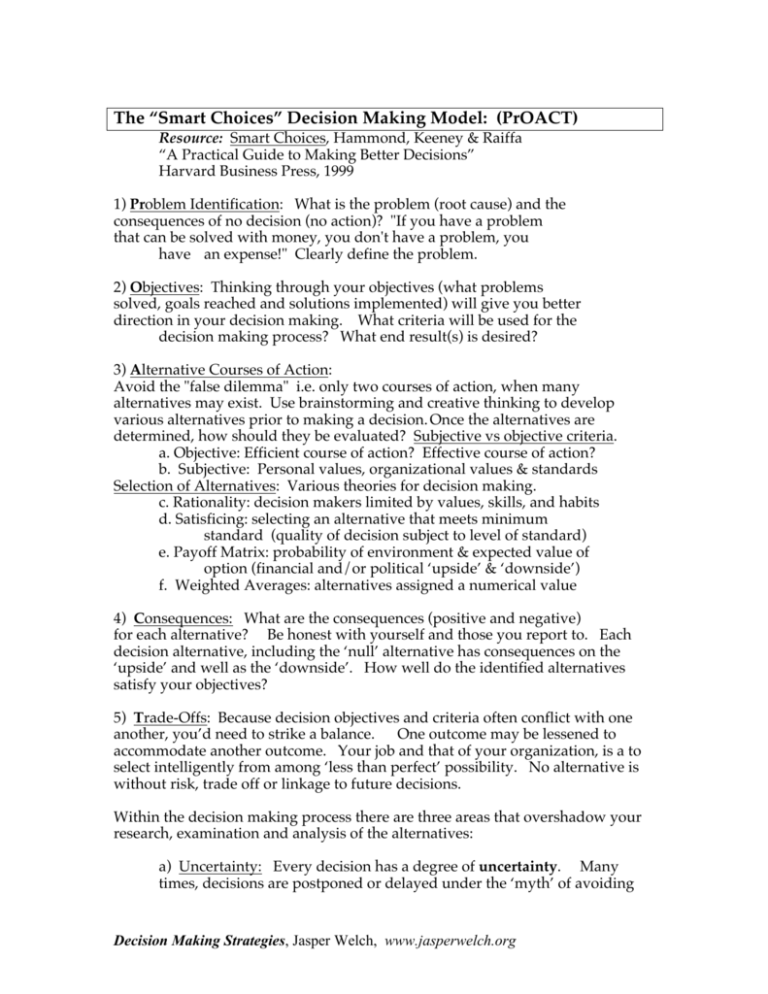
The “Smart Choices” Decision Making Model: (PrOACT) Resource: Smart Choices, Hammond, Keeney & Raiffa “A Practical Guide to Making Better Decisions” Harvard Business Press, 1999 1) Problem Identification: What is the problem (root cause) and the consequences of no decision (no action)? "If you have a problem that can be solved with money, you don't have a problem, you have an expense!" Clearly define the problem. 2) Objectives: Thinking through your objectives (what problems solved, goals reached and solutions implemented) will give you better direction in your decision making. What criteria will be used for the decision making process? What end result(s) is desired? 3) Alternative Courses of Action: Avoid the "false dilemma" i.e. only two courses of action, when many alternatives may exist. Use brainstorming and creative thinking to develop various alternatives prior to making a decision. Once the alternatives are determined, how should they be evaluated? Subjective vs objective criteria. a. Objective: Efficient course of action? Effective course of action? b. Subjective: Personal values, organizational values & standards Selection of Alternatives: Various theories for decision making. c. Rationality: decision makers limited by values, skills, and habits d. Satisficing: selecting an alternative that meets minimum standard (quality of decision subject to level of standard) e. Payoff Matrix: probability of environment & expected value of option (financial and/or political ‘upside’ & ‘downside’) f. Weighted Averages: alternatives assigned a numerical value 4) Consequences: What are the consequences (positive and negative) for each alternative? Be honest with yourself and those you report to. Each decision alternative, including the ‘null’ alternative has consequences on the ‘upside’ and well as the ‘downside’. How well do the identified alternatives satisfy your objectives? 5) Trade-Offs: Because decision objectives and criteria often conflict with one another, you’d need to strike a balance. One outcome may be lessened to accommodate another outcome. Your job and that of your organization, is a to select intelligently from among ‘less than perfect’ possibility. No alternative is without risk, trade off or linkage to future decisions. Within the decision making process there are three areas that overshadow your research, examination and analysis of the alternatives: a) Uncertainty: Every decision has a degree of uncertainty. Many times, decisions are postponed or delayed under the ‘myth’ of avoiding Decision Making Strategies, Jasper Welch, www.jasperwelch.org uncertain outcomes by not making a decision. In spite of this ‘myth’, no decision (the ‘null alternative’ or the status quo) has a degree of uncertainty. While uncertainty makes decision-making much more difficult, it is a reality that judgement and data driven processes can reduce uncertainty to a tolerable level (in most cases). b) Risk Tolerance: Each decision alternative has ‘risk’ associated with it. Even if the risk tolerance of the organization is low, a downside result can still occur. Risk can never be completely eliminated, but it can be managed and planned for. Every decision has a certain level of risk that must be managed. A certain amount of risk (of failure or poor results) must be accepted to enable the decision making process able to move forward with alternatives and implementation. No decision (“null alternative” or status quo) has risk associated with it. All options have a degree of risk. The question is: how best to manage in decision process? Many organizations have failed to reach their full potential due to risk intolerance and lack of timely decision making. c) Linked Decisions: Decisions made today will influence decisions that are going to be made tomorrow. Some decisions can be made in an incremental fashion, whereas others are global and far-reaching. Learning about decision making takes time and the understanding that decisions can be linked in more ways than first meets the eye. Once the PrOACT process is completed, the most important step is the Implementation of the Decision. What is the best timing, what adjustments have to be make ‘in the field’, who will follow-through, and what criteria and results (or lack thereof) will be used to evaluate the decision. The implementation phase can be managed with software, such as Microsoft Project and Microsoft Visio can be very useful tools in designing, communicating, tracking and actually implementing the preferred alternative. 2.1 Tools for Creative Thinking and Decision Making 1) Software that can assist in creating thinking (ThoughtOffice, Visio, Graffle ) 2) Mathematical Logic: all the numbers add up and the answer will balance! (this is also known as ‘Accounting’ logic) 3) Rock Logic: what “is” Decisions based on ‘face value’ Hard data only, not looking at ‘cause and effect’ 4) Water Logic: what will become? Situation A leads ‘to’ B Systems thinking and human perception cause & effect 2.2 Techniques for Creative Thinking 1) Brainstorming (P, N, I process) 3) SWOT survey or assessment 5) Fishbone Technique 7) Six Thinking Hats (deBono) (Groups or Processes) 2) Mind mapping (www.mindjet.com) 4) Focus Groups and Interviews 6) Force Field Analysis 8) Smart Choices (decision analysis) PrOACT “Smart Choices, Jasper Welch, FCMS www.jasperwelch.org

